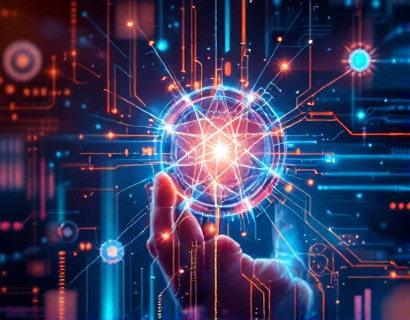Ethereum Layer 2: Unlocking Scalability and Interoperability for Developers and Enthusiasts
In the ever-evolving world of blockchain technology, Ethereum stands as a pivotal platform, renowned for its robust smart contract capabilities and decentralized applications. However, as the network grows, scalability and interoperability emerge as critical challenges. Ethereum Layer 2 solutions offer a promising pathway to address these issues, unlocking new potentials for developers and enthusiasts. This comprehensive guide delves into the intricacies of Layer 2 solutions, providing insights that are essential for anyone looking to master the next evolution of Ethereum.
Understanding Ethereum Layer 2
Ethereum Layer 2 refers to a set of solutions built on top of the Ethereum main chain (Layer 1) to enhance transaction throughput and reduce costs. These solutions do not alter the core protocol of Ethereum but instead leverage it to achieve greater efficiency. The primary goals of Layer 2 are to increase scalability, improve user experience, and maintain the security and decentralization that Ethereum is known for.
Key Layer 2 Solutions
Several Layer 2 solutions have gained prominence in the Ethereum ecosystem, each with its unique approach and benefits.
Optimistic Rollups
Optimistic Rollups are one of the most widely adopted Layer 2 solutions. They bundle multiple transactions off-chain and submit a single transaction to the Ethereum main chain, along with a proof that all off-chain transactions are valid. If any transaction is found to be invalid, the rollup operator is penalized. This approach significantly reduces gas costs and increases transaction speed without compromising security.
One of the leading optimistic rollup protocols is Arbitrum, which has gained significant traction due to its compatibility with existing Ethereum development tools and its ability to process thousands of transactions per second.
Zero-Knowledge Rollups
Zero-Knowledge Rollups, on the other hand, use zk-Rollups to bundle transactions and provide a cryptographic proof (zk-SNARKs) that the transactions are valid. This method offers even higher transaction throughput and lower fees compared to optimistic rollups, as it does not rely on time-limited challenges to validate transactions.
ZK-Rollups are less mature than optimistic rollups but are rapidly advancing. Protocols like Polygon (formerly Matic) and Loopring are at the forefront of this technology, providing a seamless experience for developers and users.
State Channels
State Channels allow for off-chain transactions between two or more parties, with the final state of the channel being submitted to the main chain once the transactions are complete. This method is particularly efficient for applications requiring frequent and fast transactions, such as gaming and decentralized finance (DeFi).
While state channels are highly efficient, they require all parties to be online simultaneously, which can be a limitation for some use cases. However, protocols like Ethereum's native Relay Chains aim to address this by enabling state channels to operate more flexibly.
Sidechains
Sidechains are independent blockchains that are linked to the Ethereum main chain through two-way pegs. They allow assets to be transferred between the sidechain and Ethereum, enabling greater scalability and interoperability. Sidechains can implement different consensus mechanisms and features, providing flexibility for developers.
Cosmos and Polkadot are prominent examples of platforms that utilize sidechain technology, though they are not exclusively Ethereum-based. However, the concept is increasingly being adopted within the Ethereum ecosystem to enhance scalability.
Benefits of Layer 2 Solutions
The adoption of Layer 2 solutions brings numerous benefits to the Ethereum ecosystem.
Increased Scalability
By processing transactions off the main chain, Layer 2 solutions significantly increase the number of transactions Ethereum can handle per second. This is crucial for supporting a growing number of decentralized applications and users without compromising performance.
Lower Transaction Costs
Layer 2 solutions reduce gas fees by minimizing the load on the main chain. This makes Ethereum more accessible and cost-effective for a broader range of users and applications.
Enhanced User Experience
Faster transaction times and lower fees translate to a better user experience. Developers can create more responsive and efficient applications, while users enjoy seamless interactions with decentralized services.
Maintaining Security and Decentralization
Despite the off-chain processing, Layer 2 solutions maintain the security and decentralization of the Ethereum network. The primary chain remains the final arbiter of state, ensuring that the ecosystem's integrity is preserved.
Challenges and Considerations
While Layer 2 solutions offer significant advantages, they also come with challenges that developers and users should be aware of.
Complexity and Integration
Implementing Layer 2 solutions can be complex, requiring developers to understand and integrate multiple protocols. This complexity can be a barrier for entry, especially for smaller projects or developers new to the ecosystem.
Interoperability
Ensuring seamless interoperability between different Layer 2 solutions and the main chain is crucial. While progress is being made, there are still challenges in achieving a fully interconnected and compatible ecosystem.
Security Concerns
Although Layer 2 solutions maintain the overall security of the Ethereum network, they introduce new points of potential vulnerability. Developers must carefully consider security best practices when building on Layer 2.
Future of Ethereum Layer 2
The future of Ethereum Layer 2 is promising, with ongoing developments and innovations set to further enhance scalability and interoperability.
Ethereum 2.0 and Layer 2 Integration
Ethereum 2.0, the ongoing upgrade to the Ethereum protocol, includes native support for Layer 2 solutions. The introduction of shard chains and the Beacon Chain will provide a more robust foundation for Layer 2 protocols, enhancing their capabilities and integration.
Emerging Technologies
New technologies such as Plasma and Cross-Link are being developed to complement existing Layer 2 solutions. These advancements aim to address current limitations and open up new possibilities for scalability and interoperability.
Conclusion
Ethereum Layer 2 solutions represent a critical step forward in addressing the scalability and interoperability challenges facing the blockchain ecosystem. By leveraging these solutions, developers can build more efficient and cost-effective decentralized applications, while users enjoy enhanced performance and accessibility. As the ecosystem continues to evolve, staying informed about Layer 2 developments will be essential for anyone looking to thrive in the dynamic world of Ethereum.



